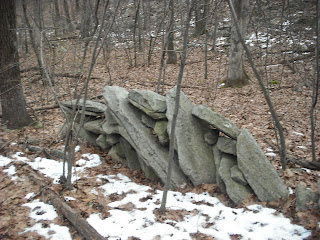Near the outcrop in the previous (9/30/2011) post runs a wall composed of standing slabs quarried from the same outcrop. Walls made of stacked stones may have been added to it later. The standing slab part is shown in solid blue lines, and the stacked part with dashed lines, in the map below. The entire wall complex has two legs, giving it a backwards "F" shape. In this part of northern RI, there are two other wall complexes with an F shape.
Red indicates manitous, and green is for bent trees. The outcrop with the sweat lodge base is at the yellow way point 277. The wall starts at blue way point 274, with this structure.
It runs about 600 feet uphill to the junction on a small outcrop described in the previous post, and shown in the photo directly below.
One leg of this wall starts at the junction, runs 300 feet northeast and downhill, and ends in a cleared area. The main part of the wall continues northwest about 350 feet from the junction until it changes into a stacked rock wall. This transition is in front of a cliff surmounted by a boulder. I once found a rusty bucket in this area. While one would expect to find old farm tools around overgrown farms, it's odd how often old buckets turn up near stone structures.
The piled rock wall continues about 250 feet, and then turns northeast, climbs and descends a small hill, and ends at a swamp.
Standing stone slabs face to face is the most inefficient use of material. Why would anyone build such an impractical and costly wall, unless it had some spiritual significance? What strikes me about this stone row is the sense of energy in the tilted slabs, like dominoes falling.
The wall crosses outcrops and ties together the landscape. In this imaginary composition, the wall seems to race past all the elements in the photos.
These are ink brush paintings containing real structures arranged to best show their features. I like black and white graphic style for smaller landscapes and subjects in which form and pattern are most important.









No comments:
Post a Comment